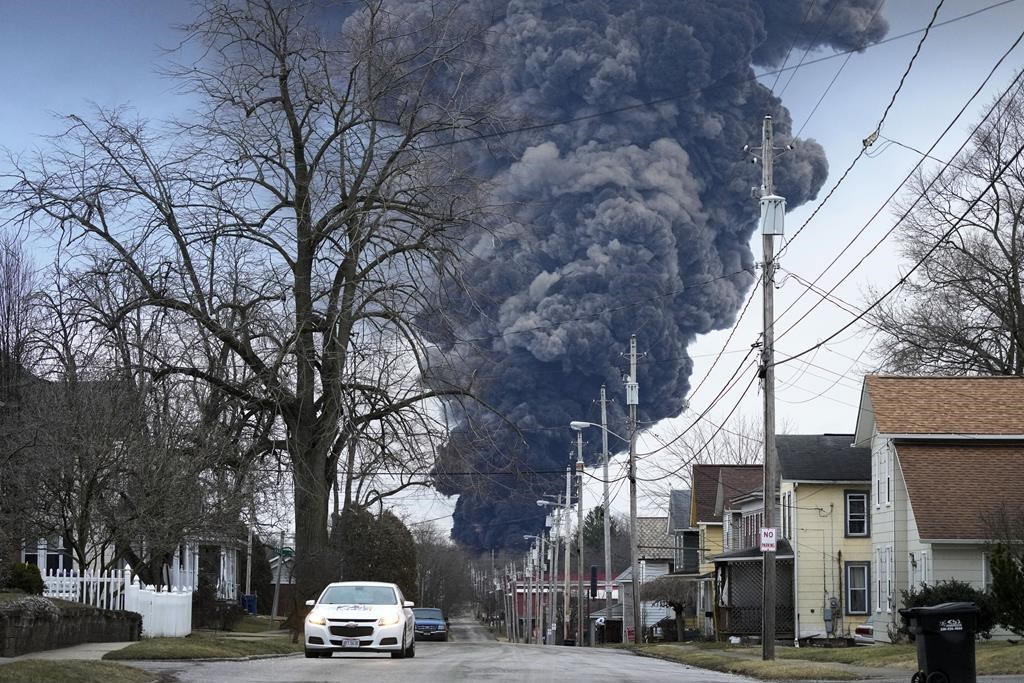Chemicals released into the environment following a disastrous train derailment in northeastern Ohio last year likely spread into southern Ontario, according to a newly published study.

The study, published Wednesday in the journal Environmental Research Letters, examined precipitation and pollution data from the weeks after the hazardous freight spill on Feb. 3, 2023. The incident saw approximately 50 Norfolk Southern Railroad train cars veer off the tracks near the small town of East Palestine.
Some of the train cars were carrying toxic vinyl chloride, a known carcinogen, and other hazardous chemicals. In dealing with the crash, officials three days later opted to burn off the chemicals to prevent explosion, triggering a large cloud of black smoke over Ohio and Pennsylvania.
Now, more than a year after the incident, researchers found chemicals from the derailment spread to 16 U.S. states, and likely into Ontario and some of the Great Lakes.
Environment Climate Change Canada last year told Global News it was “highly unlikely” that Canada would see any impacts from the rail disaster.

Researchers in the study compared rain and snow samples collected by the U.S. National Atmospheric Deposition Program (NADP) from a two-week period after the derailment and subsequent fires. The 14-day interval saw high chloride concentrations and the highest levels of pH in rain and snow recorded in the last 11 years.

Get daily National news
The study claimed high chloride concentrations, as well as the highest pH levels in precipitation, were discovered along the New York-Ontario border, which was downwind of East Palestine during the derailment period.
As the vinyl chloride burned in the controlled fire, the chemical compound broke into chloride and hydrogen ions, which were then carried on the wind. Simulated airflow models created within the study note pollutant trajectories “from the accident site clearly flowing north into Canada.”
Rain or snowfall would have carried pollution from the air to be deposited on the ground.
Researchers did not have accessible Canadian precipitation and pollution data, and only examined U.S. sites. Regardless, the study maintains chemicals were likely carried north of the border via wind and precipitation.
The pollution was spread over 1.4 million square kilometres inside the U.S., or to about 14 per cent of the country’s land area, the study notes. This includes “at least some impact” to one-third of the population, or around 110 million Americans.
Higher levels of chloride and greater pH in precipitation continued for about two weeks before returning to normal measures, likely pointing to the trainwreck as the cause of the spike, the study claims.
Researchers wrote they were “surprised” by the widespread extent of the pollution examined in the study. The geographical vastness was attributed “likely due to the uplift from the fire itself,” transporting pollutants into the atmosphere.
“There’s more going on here than most people would have guessed, including me,” David Gay, lead author of the study, told the Washington Post.
Gay said the chemical concentrations farther away from the Ohio accident site are not toxic, “but are pretty unusual at a lot of places.”
Samples collected in Pennsylvania, Michigan, Massachusetts, Wisconsin and almost every site in New York were flagged as containing soot ash and dirt.
“It’s not death and destruction. It’s fairly low concentrations, but they are very high relative to the normal that we typically see,” he described.
Along the U.S.-Canada border, pH levels in precipitation two weeks after the derailment measured up to 7.3. The U.S. EPA says normal, clean rain has a pH value of between 5.0 and 5.5. The agency noted a pH above 5.5 can be dangerous for certain marine animals like rainbow trout and crayfish.
It is not yet clear what effect, if any, the transported pollutants could have on the environment.

In February 2023, when Global News asked Environment Climate Change Canada if chemicals from the Ohio train derailment would impact Canada, the department said it was “highly unlikely.”
“Typically, the chemical involved in the controlled release to the air, vinyl chloride, only lasts in the atmosphere for less than 24 hours,” the department said in a statement at the time. “With Southern Ontario being directly north and northwest of the event location, and with the prevailing winds being from the west and southwest, it would have been highly unlikely that the region would have seen any effect.”
Global News contacted Environment Climate Change Canada for comment about the newly published study, though the department said it “does not have any further information to provide on this topic.”
East Palestine has a population of about 5,000 people.
In May, Norfolk Southern agreed to pay a settlement of more than US$310 million (more than C$425.6 million), including a US$15 million (about C$20.5 million) civil penalty alongside other costs to do with cleanup and health care. The company claimed a mechanical issue caused their train to derail.
A month earlier, Norfolk Southern reached a US$600 million (C$821.4 million) settlement as part of class-action lawsuits brought by residents of East Palestine. They payout is to “address potential adverse impacts” from the derailment, which includes health care needs, property restoration and compensation for any net business loss.






Comments